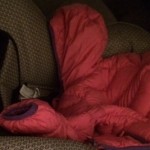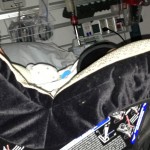In order to cut down our travel costs this past holiday season, my husband and I brought our daughter’s car seat with us when we traveled by air. To get to the airport, we took a taxi in which we had installed the seat, and then at our destination, we hooked the seat up in our rental car.
While all this installing and uninstalling was definitely a hassle, we were saving money by not leaving our car in airport parking and renting a car seat from a rental car company. One expense we weren’t saving, however, was baggage fees.
When we would check in online the night before our flights, we assumed the car seat was one more piece of baggage that we had to pay a fee for, so we counted it when calculating and paying our baggage costs. And when we arrived at the baggage drop on the day of our flights, no one mentioned to us what I’ve since learned from more experienced parent fliers: Just like you typically can check your stroller for free, it’s generally free to check your car seat.
This is why today’s hint is to bring your car seat with you when you travel via air (rather than renting it from a rental car agency), and it’s a reminder to skip paying baggage fees when you check the seat, assuming the airline you’re traveling with is one of the many that allow strollers and car seats to be checked free of charge at the curb, ticket counter or gate.
Southwest Airlines, for instance, notes on its Web site that “customers traveling with children will be allowed to check one stroller and one Child Restraint System (CRS) or car seat per child without charge.” Other airlines with similar policies include Delta, Jet Blue, American Airlines, United Airlines (find more details on United’s car seat policy here) and Virgin America, whose Web site states that “one infant stroller and one infant or child safety seat can be checked for each fare-paying guest at no charge.”
To be sure, the airlines all note that they aren’t liable for any damage that occurs between the time you drop the seat off at baggage check in a plastic bag and pick it up at baggage claim, and it’s not unheard of for a checked car seat to appear on the baggage carousel more broken than before, or even to not appear at all.
As the Car Seat Lady notes on her Facebook page, “gate-checking the car seat is problematic as many seats come back broken from luggage dropping on top of them (and some get lost).” But at the same time, renting a seat at your destination may not be a better option. Rental car agency car seats may be expired, dirty or not available, as the Car Seat Lady also recently pointed out.
For these reasons, many safety and car seat experts, including the folks over at the CarseatBlog, advocate buying a ticket for your child regardless of his or her age, and having the child ride in the car seat on a plane.
But if this isn’t a realistic option given your budget, we haven’t had any problems yet when checking our seat (besides shelling out unnecessary baggage fees, of course), and I wouldn’t be scared off by online reports that a checked car seat is as good as a crashed one.
In an August 2012 statement, which I first came across at the CarseatBlog, the Manufacturers Alliance for Child Passenger Safety, an association of car seat makers, noted that it “does not consider a gate checked car seat or a car seat that is checked as luggage to be one that has experienced forces equivalent to a motor vehicle crash.” In other words, the typical handling of luggage by airlines doesn’t generally cause the same damage to a car seat as a car crash, though the association does recommend inspecting the car seat when you arrive “to make sure no visual damage has occurred and all aspects of the car seat function properly.”
If you’re still worried about what may happen to your seat once you drop it off at check in, you could instead check it at the gate. The CarseatBlog, for instance, points out that items “that are gate-checked have less opportunity to be mishandled and are much less likely to be missing when you land.” Plus, if you have the car seat with you when you’re at the gate, you may be able to bring it on the plane with you for your little one to ride in if it’s not a full flight (though then you’ll have to figure out how to lug the seat around the airport with you).
Finally, regardless of where you check the seat, there are things you can do to help prevent damage. For example, besides putting the car seat in a clear plastic bag, you could wrap it in bubble wrap (as The Vacation Gals suggest), put it in extra garbage bags or stick it in a sturdy bag like a large duffel bag (a way to possibly cut down your overall baggage fees, as pointed out on the site Money Crashers).
What are your tips for traveling with car seats?
Follow Hint Mama on Facebook and Twitter, and read more about her and her disclosures







[…] be sure, many safety experts recommend buying a seat for your little one rather than having him or her ride on your lap. You’ll also want to make sure you’re wearing […]